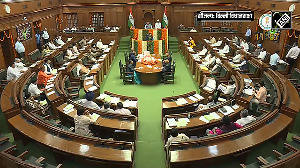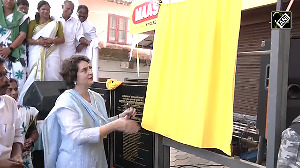In a televised address to the nation on May 4, the Maoist Prime Minister of Nepal, Pushpa Kamal Dahal, popularly known as Prachanda, dramatically announced his resignation.
The move comes in the wake of opposition to his decision the previous day to sack the 61-year-old Army Chief Gen Rukmangad Katawal following the General's opposition to the demand of Prachanda for the integration of members of the People's Liberation Army (PLA) raised by the Maoists during their days in the insurgency into the Army.
Gen. Kul Bahadur Khadka, the No.2 in the Army, was asked by Prachanda to act as the Chief of the Army Staff (COAS) until further orders.
Before announcing his decision, Prachanda met with Katawal and Khadka separately first, then jointly, before seeking the approval of the Cabinet for sacking the COAS. His decision was opposed by the Communist Party of Nepal (United Marxist-Leninist) with 108 members in the Constituent Assembly, which decided to quit the ruling coalition Government.
"We decided to withdraw our support to protest the Prime Minister's unilateral decision," CPN-UML General Secretary Ishwar Pokhrel said.
While the Nepali Congress and the Madhesi Peoples Party joined 17 other parties in opposing the sacking of the General , the Madhesi People's Rights Forum (MPRF) with 51 members in the Assembly and some other smaller parties maintained an ambivalent attitude. The MPRF reportedly submitted a note of dissent disagreeing with Prachanda's decision, but did not leave the coalition. The CPN-Maoist with 229 seats in the Constituent Assembly needed the crucial support from MPRF and other small parties to continue to enjoy a majority in the 601-member Assembly tasked to frame a new constitution for the country after it abolished its unpopular 240-year-old monarchy last year.
Prachanda's action in unilaterally sacking the Army Chief despite strong opposition in the coalition Cabinet was nullified by the President Ram Baran Yadav, who faxed a special instruction to the Chief of the Army Staff "asking him to continue in his office in the capacity of COAS as per the Interim Constitution, 2007, and the existing law".
The spokesman of the Maoists, Krishna Bahadur Mahara, who is the Minister for Information and Communication, told the media that the President's order to the COAS to continue in office was tantamount to a "constitutional coup" and said that the Maoists would fight back with street protests.
He said: "The President is violating constitutional norms. The President's move has put the peace process in peril. Our party has taken the President's step as a constitutional coup and we will fight against it. The executive power to sack and appoint an acting army chief lies with the government and not the President. We will stick to our decision. We don't have any plans to quit the Government."
Prachanda called the Attorney General Raghav Lal Baidya and senior Cabinet colleagues early on May 4 to discuss the constitutionality and consequences of the President's intervention. There was speculation that the Maoists might move for the impeachment of the President. After finding that they would not have the required support for such a move in the Constituent Assembly, he decided to resign.
It remains to be seen whether his resignation is a purely tactical move to confront the other members of the ruling coalition with the danger of serious political instability if they did not support his sacking of the Army chief or was forced by his realizing that there was no way he could have his way against the Army chief. Both the Army chief and Prajwal, the Commander of the seventh division of the PLA, were reported to have ordered the two forces under their respective command to remain in a state of alert to prevent any disturbance of law and order.
The peace accord reached by various political parties before last year's election to the Constituent Assembly had provided for the rehabilitation and integration of the members of the PLA and other Maoist cadres, including members of the people's courts set up by the Maoists during their days in the insurgency.
After Prachanda assumed office in August last year as the Prime Minister, differences surfaced over the interpretation of this principle. The Maoists treated rehabilitation and integration as synonymous and insisted that the only of rehabilitating the 19,000 members of the PLA was by integrating them into the Army, barring those physically unfit or unwilling to serve in the Army.
The Army and other political parties were strongly opposed to this. They held that rehabilitation and integration were two different processes. According to them, rehabilitation meant enabling the Maoist cadres to be gainfully employed, but not necessarily in the Army. While they were prepared to consider the integration of small numbers of the PLA into the Army if they were found to be professionally suitable, they were not prepared to agree to the wholesale merger of the PLA into the Army. Such an action would have resulted in about one-fourth of the Army consisting of indoctrinated Maoists, with their number steadily increasing with fresh recruitment.
Prachanda also wanted that the Maoists, who held officer-equivalent ranks in the PLA, should be given appropriate ranks in the Army. Thus, he reportedly wanted PLA commander Nanda Kishor Pun "Pasang" to be made a Major General and many others to get the rank of Brigadiers. He also reportedly wanted that there should be no new recruitment to the Army for some years.
Neil Horning, an American expert on the Maoist movement of Nepal, who is himself believed to be sympathetic to the Maoists, wrote: "The mainstream parties, as well as the elite in the army, view army integration in an apocalyptic light. While integrating the PLA into the NA was agreed upon time and again in the course of peace negotiations, the Non-Maoist parties made their agreements under the assumption that the Maoists could not possibly win electoral victory, and would not be in charge of implementing the integration. They counted on returning to the long standing Nepali political habit of agreeing to a demand in negotiation and then reneging on it later when the opponent is not in a position to make a challenge. They are trying to do the same now by continually insisting that Maoists combatants be "rehabilitated" rather than integrated, but it is they who have lost their bargaining position. Yet, why can't they let it happen in the first place? The Maoists don't have more than 20,000 troops to integrate into the more than 90,000 currently in the Army. This would hardly make the army into a force at the Maoists' beck and call. It's not that the army would become the private force of the Maoists, but that it would cease to be a check on them. With at least 25 per cent of troops and officers being former Maoist partisans, the possibility of a reactionary coup becomes impossible. The troops needed to suppress the public would simply turn their weapons on the command. Therefore, the army would cease to be a check and social change would continue unabated."
According to Kanak Mani Dixit, the Nepali political analyst, "At their large National Council conclave in the Kharipati outskirts of Kathmandu in late November 2008, the Maoists came to the conclusion that they were in government but did not control the state, for which the Nepal Army and the independent judiciary were found to be prime obstacles. It decided that the (Maoist) cantonments should not be disbanded until the new constitution is written."
When the Maoists found that whenever they had a dispute with the Army over issues such as the ban on new recruitment which was disregarded by the COAS the judiciary was taking up a position, which was unfavourable to the Maoists, they also started talking of integrating the members of the former Maoists' people's courts into the judiciary.
The COAS went ahead with the new recruitment recruiting nearly 2800 persons to fill up existing vacancies in the Army and the PLA retaliated by making fresh recruitment to the PLA in violation of the Comprehensive Peace Agreement. Thus, Nepal under Prachanda as the Prime Minister saw the spectre of two parallel armies---- the state Army and the non-State PLA--- strengthening and preparing themselves for a future confrontation should the Maoists' demand for total integration be turned down.
While the Chinese closely monitored the situation by interacting intensely with various political formations, India and the US reportedly cautioned Prachanda against a confrontation on this issue. Prachanda increasingly became unresponsive to the advice for moderation from India and the US and insisted on having his way.
It is not clear why Prachanda decided to force a confrontation with the COAS at this stage instead of waiting till September, when Gen.Katawal is due to superannuate. One possible reason for his hasty action is that Gen.Khadka, who is believed to be not opposed to the integration of the PLA into the Army, is due to superannuate in June. It is suspected that Prachanda wanted to make him the chief before his superannuation and give him a two-year tenure so that the integration of the PLA into the Army could be brought about without any further opposition from the Army. His plans were thwarted by the President.
What could happen now? The following are the possible scenarios:
A serious political crisis with violent demonstrations by the Maoists which results in one more compromise. The Chinese will try their best to see that the Maoist-led Government, which has effectively put down Tibetan activity in Nepali territory, remains in power.
A violent confrontation between the PLA and the Army leading to an army coup.
A new coalition without the Maoists, which will be unstable.
In one of my articles then, I wrote: "Taking advantage of the popular uprising of 2006 against the widely detested King, the Maoists entered the coalition Government, which replaced a Government of royalist stooges, and started dictating terms as to how the integration should take place. They themselves became one of the policy-makers to decide on the process of integration. The integration is taking place not on the basis of negotiations between the Government and the insurgents, but in response to diktats issued from time to time by the Maoists in return for their continued participation in the Government. They are all the time giving out discreet threats that if their diktats are rejected, they might quit the Government and revert to insurgency.
The holding of the elections to the Constituent Assembly before the ground rules for integration were agreed upon and the victory of the Maoists in the elections----significant, but not spectacular as projected by sections of the media--- have led to a situation where the Maoists will be at the head of a Government which will take crucial decisions on the post-facto legitimisation of the terrorist infrastructure raised by the Maoists and on the ground rules for the integration of their ideologically motivated and well-trained cadres. The moment the Maoists assume leadership in the seats of power and decision-making, will it be possible to resist their demands? If the integration of over 3000 ideologically indoctrinated cadres of the insurgent army into the Nepal Army comes about, we will have to the west of us an army ideologically motivated by jihadi doctrines and to the east of us an army ideologically motivated by Marxism, Leninism and Mao's Thoughts. There are two possible scenarios--- these fears turn out to be baseless and Prachanda turns out to be a genuine democrat and a genuine friend of India or Prachanda after the elections turns out to be different from Prachanda before the elections and takes Nepal on a road, which would be detrimental to our national interests. While hoping for the first scenario, we must be prepared for the second. "
In a subsequent article, I wrote: "Addressing the Nepal Council of World Affairs at Kathmandu on August 5, 2008, the Chinese Ambassador to Nepal Zheng Xianglin said: "Nepal is situated in a favorable geographical position in South Asia, and is a passage linking China and South Asia." That is the reason for the Chinese interest in Nepal----as a passage to South Asia and as an instrument for strengthening the Chinese presence in South Asia. China has a Look South policy to counter our Look East policy.
As we try to move Eastwards to cultivate the countries of South-East Asia, it is trying to move southwards to outflank us. China is not a South Asian power, but it already has a growing South Asian strategic presence -- in Pakistan, Sri Lanka and Bangladesh. It is hoping to acquire a similar presence in Nepal with the co-operation of a Maoist-dominated Government."
China would try its best to see that the Maoists stay in power. Their continuance in power in Kathmandu is important for stability in Tibet. In the past, we supported Maoists thinking that Prachanda would take a neutral line between India and China. These hopes are elusive. Should we facilitate the Chinese designs in Nepal by bringing about a political compromise which would enable the Maoists to continue in power or has the time come to work for a non-Maoist alternative? This requires serious examination in our policy-making circles.






 © 2025
© 2025